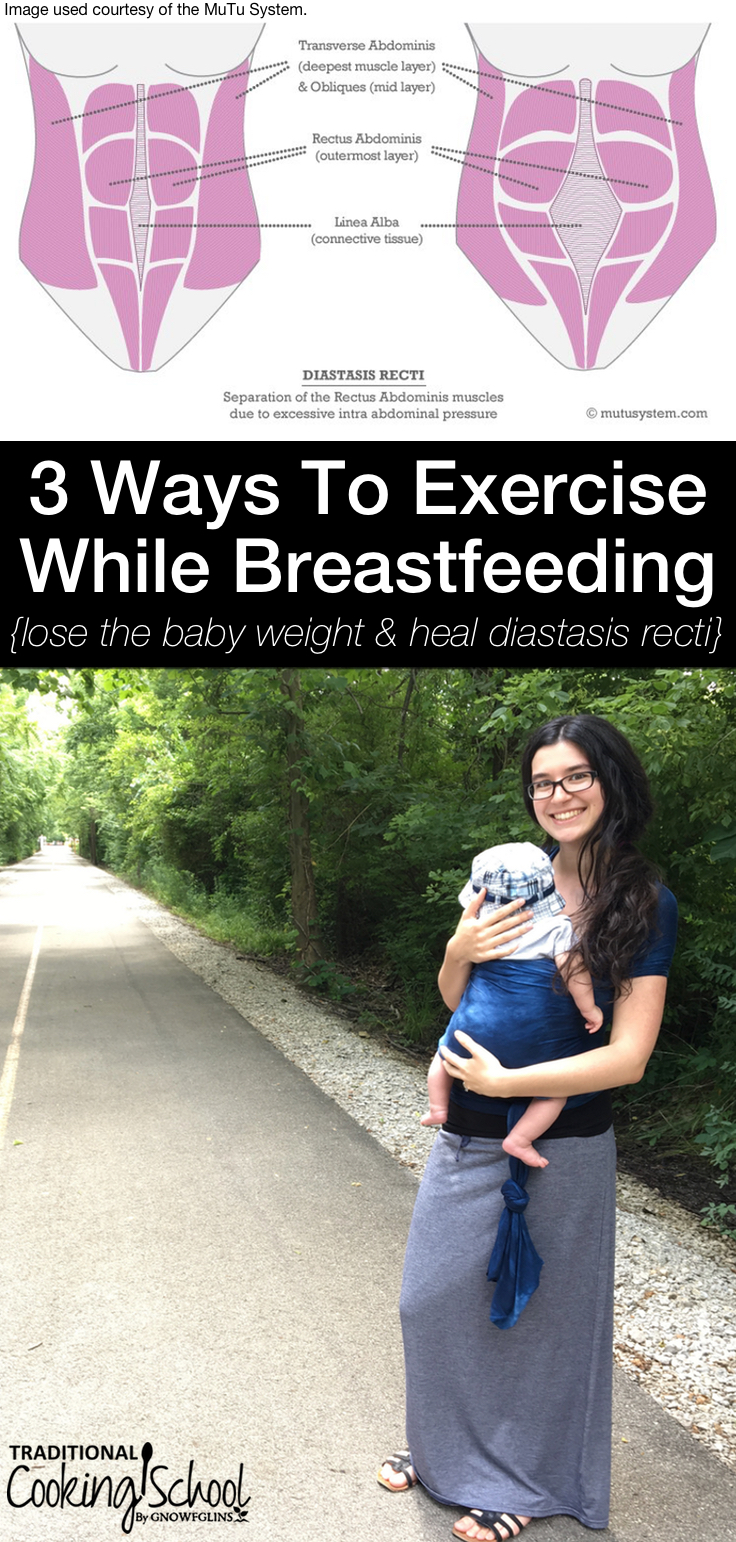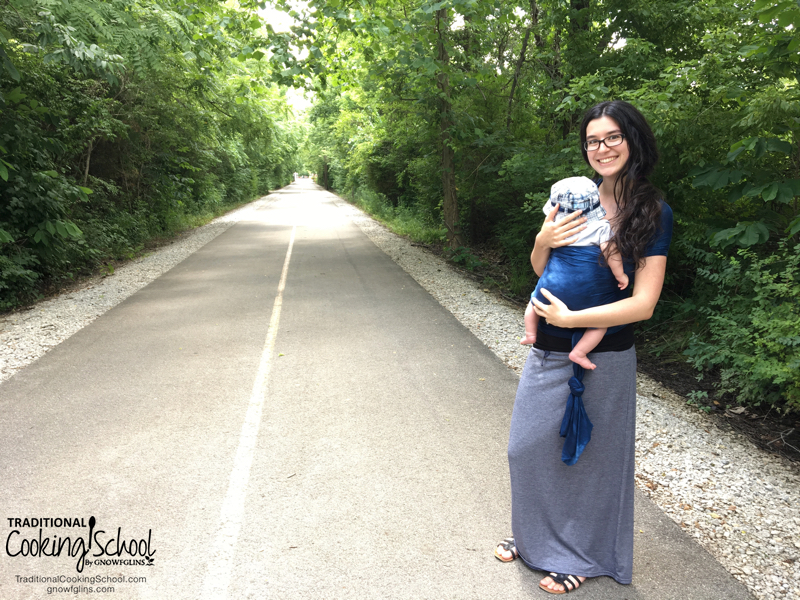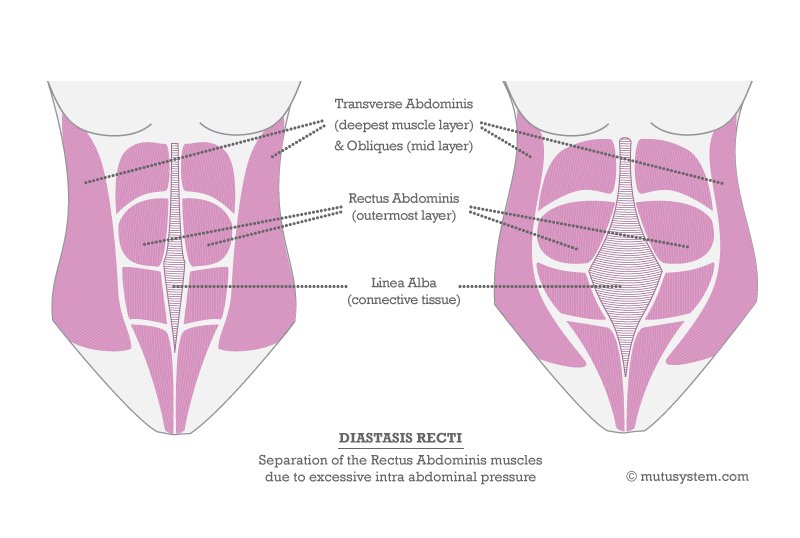
I didn’t like being pregnant…
Don’t get me wrong — it’s a beautiful time of life — but it’s hard, too. Between the nausea, the ligaments that felt like they were on fire, and the 65-pound weight gain that made me feel more walrus than woman, I was pretty miserable.
And yet, 9 months doesn’t last forever. When baby finally came, I felt like a new person — one who could sleep on her stomach and tie her shoelaces and brush her teeth normally again! Over the spring and summer, I lost the baby weight while continuing to breastfeed. Now, this fall, I’m tackling my diastasis recti (see below).
Let’s explore the basics of how to exercise while breastfeeding… then dive into practical tips to lose the baby weight and heal diastasis recti, even as a busy new mom!
How To Exercise While Breastfeeding, Lose The Baby Weight, & Heal Diastasis Recti
Keep these simple guidelines in mind — they are foundational so you can lose weight and nourish your body while keeping your milk supply strong and baby healthy.
To maintain an abundant milk supply, most women need to eat between 1800 and 2200 calories per day. Any less than 1500 to 1800 calories per day, and your supply will probably begin to falter. Keep in mind that breastfeeding itself burns an average of 200 to 500 calories per day on top of your body’s normal requirements. Also, every woman is different! Is your milk supply strong? Is your baby happy and growing? Then you’re doing fine. (Source and source.)
If you’re within the first 2 months postpartum, don’t skip meals or go on a diet to lose the weight. Eat 3 square meals a day with snacks. Avoid empty calories in favor of nutrient-dense foods.
After the first 2 months, serve yourself smaller portion sizes and/or snack less often. At this point, your milk supply is better established and baby is growing well and needing to nurse less often (hopefully — if not, see your pediatrician and don’t follow this step). It’s okay to have a small calorie deficit to allow yourself to lose the baby weight. Aim for losing about 1 to 1-1/2 pounds per week.
While it’s normal for weight to fall off suddenly in the first 2 months, after that you want weight loss to be slow and steady. Be aware of your milk supply — if it suddenly decreases, eat more.
After 6 weeks, moderate exercise should have no effect on milk supply (source)! That’s the equivalent of a brisk walk, or walking about 4 miles per hour. While full recovery can take up to a year, for a vaginal childbirth with no complications, women will probably feel better and stronger physically by about 6 to 8 weeks. Of course, every woman is different, so listen to your own body. 🙂 Generally speaking, however, take it easy until that point, but after that, go for it!
Now let’s explore some practical ways to exercise while breastfeeding…
#1 — Take Walks
Especially in the initial postpartum period when you may not be up for much else, walking is wonderful! It’s gentle yet effective, eases constipation, and strengthens pelvic floor muscles.
Fresh air and sunshine will be good for both you and baby — and if you can, try to get your bare feet in the soil while you’re outside.

#2 — Wear Your Baby…
…in a baby wrap, ring sling, soft-structured carrier, or whatever works for you! I personally love my Solly wrap (pictured above). Babywearing not only comforts baby, helps him breathe, and helps him develop fine motor skills (source) — it can help you exercise by forcing you to activate your core and move around with more weight. Plus, who doesn’t love snuggles on the go?
You can even combine #1 and #2 by taking walks while wearing your baby. 😉 Boom!
#3 — Heal Diastasis Recti By Using The MuTu System Exercise Program
Mummy tummy.
That’s what the MuTu System exercise program stands for. It’s specifically designed to help moms strengthen their core + pelvic floor muscles, as well as heal diastasis recti. In other words, it helps moms get rid of their “mummy tummy”.
I’m currently taking their 12-week exercise class, and I love it! My 2-finger-width wide diastasis is already down to 1-finger-width after only 3 weeks. 1 to 2 finger widths is considered within the realm of normal, but either way it is certainly wider than it was before my pregnancy. So I’m trying to improve it while also strengthening my admittedly weak core muscles.
One of the best parts of this program, in my opinion, is that Wendy (the founder) explains the importance of exercising in conjunction with proper nutrition, hormone balance, reducing stress, and getting enough sleep. These are all super important concepts that we’ve been exploring in-depth in our Women’s Health eCourse!
And then, Wendy demonstrates the simple yet effective exercises on video — so you know exactly what you need to do!
What is diastasis recti? It’s a separation of the abdominal muscles due to excessive intra-abdominal pressure, such as that caused by later pregnancy. It especially occurs in women who have had multiple babies, or in women whose core muscles are weak (like me).
In the picture below, you can see how the connective tissue on the torso on the left is thin and taut, and the abdominal muscles are close together so they can fully support the internal organs and spine. On the right, the connective tissue becomes stretched out and the muscles are far apart.
This gap, or diastasis, of connective tissue between the abdominal muscles can allow internal organs to sag outward or even protrude through the muscle separation. This causes the so-called “mummy tummy”.

Image used courtesy of MuTu System.
How do you exercise while breastfeeding? Have you managed to lose the baby weight with each pregnancy?
Looking for more pregnancy and baby related articles?
We only recommend products and services we wholeheartedly endorse. This post may contain special links through which we earn a small commission if you make a purchase (though your price is the same).


I highly recommend the MuTu system. I’ve had 9 pregnancies, 8 full-term and I developed an umbilical hernia after my 8th pregnancy. It took me a year to complete the 12 week course (so plug away, Mama’s, even if it takes forever to complete!) and my hernia is much smaller. More than that, MuTu taught me how to move and exercise safely, how to engage my core when lifting or turning. I’ve now completed a very challenging 12 week exercise program that includes exercises I couldn’t have safely done if I hadn’t completed MuTu first. Thanks for all the helpful information!
Fit2Be and the Tummy Team both have great programs too! I have greatly benefited from both websites and done a lot of healing from my hand width wide gap. Thank you for sharing your experience! It is SO necessary for women to be aware of Diastasis, and that help can got gotten through exercises in a lot of cases. I was not informed, until I was in bad shape after my fifth baby. THANKS AGAIN! 🙂
I used Mamalates after our 4th baby. And plan on starting again soon, now that we’ve had a fifth. It was very helpful. I try not to do anything to lose weight. It seems to work well for me so far. With the first 3 babies, the weight came off quickly. Maybe too quickly. Now that I’m approaching 40, the last 2 have been slower. And that’s totally fine! I notice that around 10-12 months postpartum, something shifts and weight seems to come off effortlessly. I would much rather wait and let my body do its thing than worry about it. I love being able to enjoy my babies and not have any worries about a weight loss plan. I find comfort in knowing that by eating a clean, traditional diet, I don’t need to worry. I tend to gain about 50+ lbs with each pregnancy. I am still up 30 lbs from normal at 10 months postpartum. I noticed that 2 weeks ago, like clockwork, I started losing 2 lbs a week while doing nothing differently. I really believe in this way of eating. And I also think that each woman’s body is unique, so there are many ways to lose the weight. ?